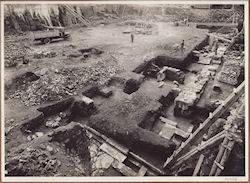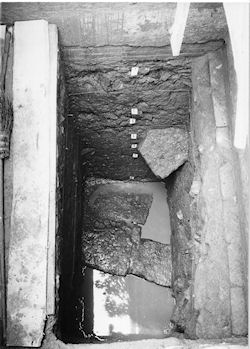

Figure 32: View of S. Omobono during the rescue work of 1937 (AFSRCM).
Figure 33: Stratigraphic sounding in the area of the Archaic temple (AFSRCM).
Since its fortuitous discovery, S. Omobono has in many ways become emblematic of established theoretical and methodological traditions in the study of Early Rome and within Italian classical archaeology more generally. The range of approaches applied to the site constitutes a microcosm of the broader intellectual development of classical archaeology in Italy, from the unabashed idealism of the first half of the 20th century and the idealist Marxism of the post-war period to the fully fledged materialism that took root in the 1970s (Terrenato 2005), all of which survive more or less intact in the holistic antiquarianism of recent decades. Over the past 70 years, these successive theoretical frameworks have profoundly influenced the focus of fieldwork at S. Omobono, as even a brief review of the available site reports and archival documents makes clear.
The first account of the area of S. Omobono, published in 1938, is strongly evocative of the idealistic turn in Italian classical archaeology at the time, with its emphasis on art and monumentality. The report, for instance, details how in the course of the rescue work several portions of residential blocks (insulae) and storage facilities in the immediate vicinity of the temple complex were returned to construction crews; domestic remains of this type were of only 'scarso interesse' (scarce interest) (Colini 1938b, 280), and 'la natura del quartiere non poteva far sperare ritrovamenti di opere d'arte' (the nature of the neighbourhood could not fuel hopes of finding artwork; Colini 1938b, 279). Accordingly, rescue efforts focused on the monumental remains in the immediate surroundings of the church of S. Omobono, which were excluded from the ongoing construction project as evidence of 'un'area sacra di veneranda antichità' (a sacred area of venerable antiquity) (Colini 1938b, 280). In addition to playing a role in reducing the area of the fieldwork, the idealistic slant of the time largely determined the methodological details of the work carried out in the 'sacred area'. Only components of the recovered assemblage that were deemed noteworthy—select ceramic vessels, architectural terracottas, and statues—were collected and documented (Colini 1938b, 281).
Just as the full importance of the site was beginning to be realised, the war prematurely ended excavations at S. Omobono. The global conflict and post-war introspection had a significant impact on the Italian intellectual climate. After a prolonged hiatus, as Marxist perspectives were increasingly taking root in Italian classical archaeology, work at S. Omobono resumed in 1959. This second phase of research began with the excavation of a sounding outside the apse of the church by Gjerstad, who wished to include the earliest evidence from S. Omobono in his seminal series of volumes on Early Rome; the work was conducted under the aegis of Colini and in collaboration with Ioppolo (Colini 1962, 3). Accordingly, the 1959 sounding targeted archaic levels. This chronological emphasis set the tone for much of the fieldwork and other studies that have been carried out since, though significant attention has also been paid intermittently to the architectural development of the Republican and later phases (e.g. Mercando 1966; Sommella 1968).
The new wave of work at S. Omobono was characterised by a restricted focus on the construction sequence of the sacred area in relation to the holistic historical framework then being developed by Italian liberal historiography. Within the broader historical establishment, the spiritual universalism inspired by Benedetto Croce had begun to give way to the rigorous political historiography of Gaetano De Sanctis and Arnaldo Momigliano, who actively advocated a partnership with archaeology, however unequal, especially with reference to Early Rome:
'Through the words of Livy and Dionysius the modern historian is in direct contact with what generation after generation of Romans thought about themselves. The pure archaeologist cannot rely on the living memory: he has to guess and to infer, very often by analogy. [...] But of course archaeology can act as an excellent control of a literary tradition. [...] As early Rome is the ideal place to combine archaeological exploration and source criticism, the study of Archaic Rome remains an ideal school of historical method' (Momigliano 1963, 107-8)
The new intellectual affiliation of Italian classical archaeology was reflected clearly in the work at S. Omobono. The open, unsystematic disinterment of the pre-war excavation suddenly gave way to focused soundings designed to elucidate the chronology of construction and, to a lesser degree, the cultural and sociopolitical contexts of the distinct phases of construction (Figs 32-33).


Figure 32: View of S. Omobono during the rescue work of 1937 (AFSRCM).
Figure 33: Stratigraphic sounding in the area of the Archaic temple (AFSRCM).
This shift in the focus of fieldwork at the site was strongly influenced by an ongoing methodological debate concerning the relative value of chronologies obtained through stratigraphic excavation versus the more conventional approach of dating structural remains by reference to their construction techniques and other formal attributes. The importance of the stratigraphic method was advocated most forcefully by Nino Lamboglia, who lamented the dearth of systematic excavations within Italian archaeology (1958). The traditional approach, on the other hand, was defended by Giuseppe Lugli, head of the school of topography at the University of Rome, who argued that absolute dates obtained through stratigraphic excavation were not necessarily reliable because of the problems inherent in the construction of relative typologies (1959).
The post-war work at S. Omobono, on the whole, was more closely aligned with the latter position. While the new soundings certainly took into account the stratification of the archaeological deposits at the site, their limited extent and ad hoc recording methods left room for significant doubts regarding the interpretation of crucial segments of the stratigraphic sequence. The unresolved debate concerning the attribution of the 6th-century BCE votive deposit from the site to the first or second phase of the archaic temple provides a striking example of the consequences of this methodological orientation (see Adornato 2003, 814-16 and 819-21 and Brocato's re-evaluation of this problem in the present contribution, which is based on a careful study of archival materials). In these respects, then, the 'stratigraphic' work at S. Omobono did not pay much attention to Lamboglia's warning that
'anche il sistema dei 'saggi' stratigrafici estesi a brevi superfici di terreno, per ottenere un ristretto campionario di pezzi e risolvere speditamente i problemi, può diventare tanto fallace e superficiale quanto lo scavo tumultuario e sbrigativo che ha dominato finora' (Lamboglia 1958, 170)
Despite these problems, at S. Omobono, perhaps earlier than at other sites, the idealism of the pre-war era seamlessly morphed into straightforward materialism. As the stratigraphic exploration of the site continued, however limited in spatial extent, more lines of evidence were pursued in an effort to reconstruct the changing patterns of use and institutional character of the area from the earliest traces of occupation to the radical reorganisation of the Imperial period. To this phase, for instance, belong thorough programs of archaeobotanical and archaeozoological analysis, pioneering both in their early date and broad methodological scope (Costantini and Costantini Biasini 1989; Ioppolo 1972; Tagliacozzo 1989; for the persistent paucity of such studies within Italian classical archaeology, see Motta 2002, 71, and De Grossi Mazzorin 2006, 77-80), as well as a detailed investigation of the patterns of use of one of the Imperial tabernae installed within the podium of the twin temples (Colini et al. 1978, 422-8).
Nevertheless, the idealistic cultural historical framework of interpretation described above still played an important role in the interpretation of S. Omobono. The archaeological evidence for the development of the site derived from the new series of excavations was merged fluidly and somewhat uncritically with accounts of the site by ancient authors. In a full realisation of Momigliano's methodological vision, archaeology provided the sequence of events, history their meaning. Thus, for instance, important architectural and ritual developments were viewed in terms of distinct historical episodes recorded in later written sources:
'Il primo impianto del podio dei Templi Gemelli si ritiene oggi di poter datare [...] al V secolo, cioè al periodo di attività edilizia specialmente templare, corrispondente all'inizio del regime repubblicano, il quale si potè indubbiamente giovare della grande organizzazione creata dai Tarquinii (c'erano, tra l'altro, le maestranze resesi libere per la fine dei lavori del Tempio Capitolino)' (Colini et al. 1978, 420; for a similar blend of historical and archaeological data with regard to other phases of the site, see Pisani Sartorio and Virgili 1979, 45
Over the last three decades, work at S. Omobono has proceeded primarily as a function of restoration and other maintenance activities within the church and in the surrounding area (Ramieri 2005a). In the absence of a concerted research program, several publications have attempted to incorporate the various available lines of evidence for the area into broader reconstructions of specific phases of development. This approach, characterised by a discursive, eclectic amalgamation of diverse analytical approaches, from philology and art history to topography and the history of religion, was embodied most fully by the 1989 exhibition of the Archaic materials from the site. The associated catalogue presents reconstructions of the architecture and decoration of the earliest temple side-by-side with archaeobotanical and archaeozoological analyses, drawing selectively from the available evidence to produce a comprehensive reconstruction of the early phases of the site's history (Pisani Sartorio et al. 1989).
The evidence produced by these diverse approaches and the resulting debates about the development of the site are discussed in two separate sections, one dealing primarily with archival documents from the fieldwork conducted before and after WWII and the other with published interpretations.
© Internet Archaeology/Author(s)
University of York legal statements | Terms and Conditions
| File last updated: Mon Mar 12 2012